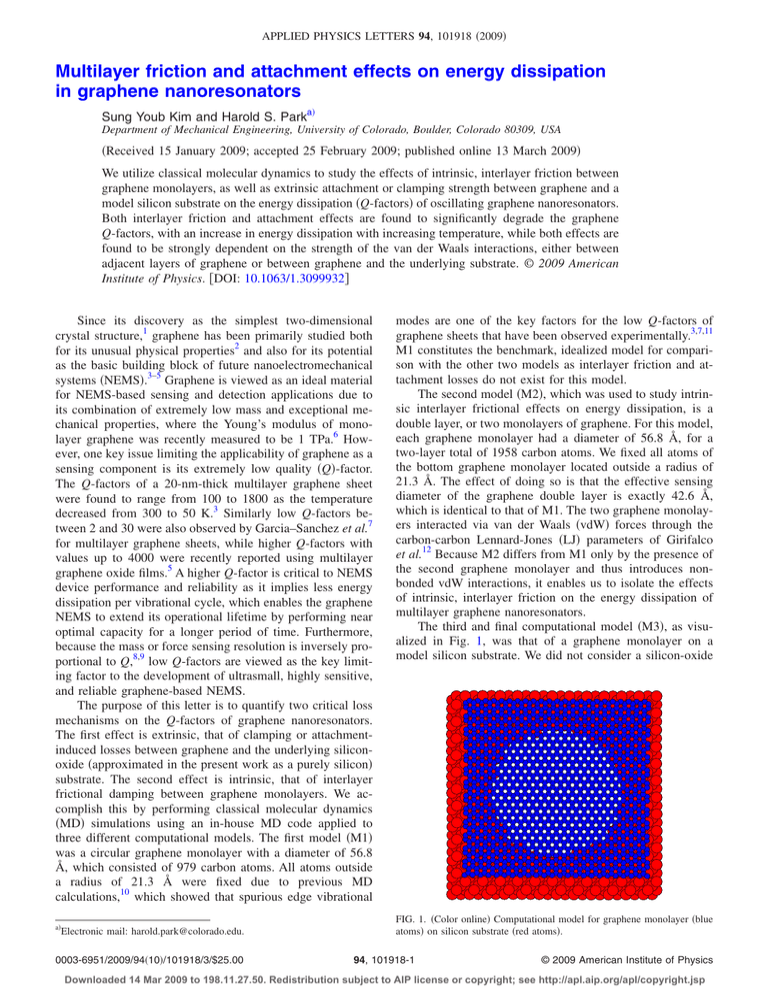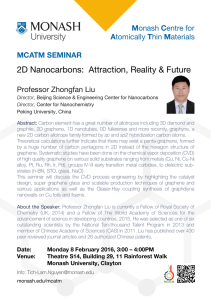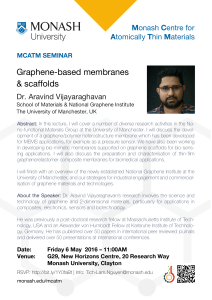Multilayer friction and attachment effects on energy dissipation in graphene nanoresonators
advertisement

APPLIED PHYSICS LETTERS 94, 101918 共2009兲 Multilayer friction and attachment effects on energy dissipation in graphene nanoresonators Sung Youb Kim and Harold S. Parka兲 Department of Mechanical Engineering, University of Colorado, Boulder, Colorado 80309, USA 共Received 15 January 2009; accepted 25 February 2009; published online 13 March 2009兲 We utilize classical molecular dynamics to study the effects of intrinsic, interlayer friction between graphene monolayers, as well as extrinsic attachment or clamping strength between graphene and a model silicon substrate on the energy dissipation 共Q-factors兲 of oscillating graphene nanoresonators. Both interlayer friction and attachment effects are found to significantly degrade the graphene Q-factors, with an increase in energy dissipation with increasing temperature, while both effects are found to be strongly dependent on the strength of the van der Waals interactions, either between adjacent layers of graphene or between graphene and the underlying substrate. © 2009 American Institute of Physics. 关DOI: 10.1063/1.3099932兴 Since its discovery as the simplest two-dimensional crystal structure,1 graphene has been primarily studied both for its unusual physical properties2 and also for its potential as the basic building block of future nanoelectromechanical systems 共NEMS兲.3–5 Graphene is viewed as an ideal material for NEMS-based sensing and detection applications due to its combination of extremely low mass and exceptional mechanical properties, where the Young’s modulus of monolayer graphene was recently measured to be 1 TPa.6 However, one key issue limiting the applicability of graphene as a sensing component is its extremely low quality 共Q兲-factor. The Q-factors of a 20-nm-thick multilayer graphene sheet were found to range from 100 to 1800 as the temperature decreased from 300 to 50 K.3 Similarly low Q-factors between 2 and 30 were also observed by Garcia–Sanchez et al.7 for multilayer graphene sheets, while higher Q-factors with values up to 4000 were recently reported using multilayer graphene oxide films.5 A higher Q-factor is critical to NEMS device performance and reliability as it implies less energy dissipation per vibrational cycle, which enables the graphene NEMS to extend its operational lifetime by performing near optimal capacity for a longer period of time. Furthermore, because the mass or force sensing resolution is inversely proportional to Q,8,9 low Q-factors are viewed as the key limiting factor to the development of ultrasmall, highly sensitive, and reliable graphene-based NEMS. The purpose of this letter is to quantify two critical loss mechanisms on the Q-factors of graphene nanoresonators. The first effect is extrinsic, that of clamping or attachmentinduced losses between graphene and the underlying siliconoxide 共approximated in the present work as a purely silicon兲 substrate. The second effect is intrinsic, that of interlayer frictional damping between graphene monolayers. We accomplish this by performing classical molecular dynamics 共MD兲 simulations using an in-house MD code applied to three different computational models. The first model 共M1兲 was a circular graphene monolayer with a diameter of 56.8 Å, which consisted of 979 carbon atoms. All atoms outside a radius of 21.3 Å were fixed due to previous MD calculations,10 which showed that spurious edge vibrational a兲 Electronic mail: harold.park@colorado.edu. 0003-6951/2009/94共10兲/101918/3/$25.00 modes are one of the key factors for the low Q-factors of graphene sheets that have been observed experimentally.3,7,11 M1 constitutes the benchmark, idealized model for comparison with the other two models as interlayer friction and attachment losses do not exist for this model. The second model 共M2兲, which was used to study intrinsic interlayer frictional effects on energy dissipation, is a double layer, or two monolayers of graphene. For this model, each graphene monolayer had a diameter of 56.8 Å, for a two-layer total of 1958 carbon atoms. We fixed all atoms of the bottom graphene monolayer located outside a radius of 21.3 Å. The effect of doing so is that the effective sensing diameter of the graphene double layer is exactly 42.6 Å, which is identical to that of M1. The two graphene monolayers interacted via van der Waals 共vdW兲 forces through the carbon-carbon Lennard-Jones 共LJ兲 parameters of Girifalco et al.12 Because M2 differs from M1 only by the presence of the second graphene monolayer and thus introduces nonbonded vdW interactions, it enables us to isolate the effects of intrinsic, interlayer friction on the energy dissipation of multilayer graphene nanoresonators. The third and final computational model 共M3兲, as visualized in Fig. 1, was that of a graphene monolayer on a model silicon substrate. We did not consider a silicon-oxide FIG. 1. 共Color online兲 Computational model for graphene monolayer 共blue atoms兲 on silicon substrate 共red atoms兲. 94, 101918-1 © 2009 American Institute of Physics Downloaded 14 Mar 2009 to 198.11.27.50. Redistribution subject to AIP license or copyright; see http://apl.aip.org/apl/copyright.jsp 101918-2 7 10 6 M1: Mono Layer M2: Double (One fix) M2: Double (Two fix) M3: Mono on Si (x8) M3: Mono on Si (x4) Quality Factor 10 Appl. Phys. Lett. 94, 101918 共2009兲 S. Y. Kim and H. S. Park 105 104 103 10 2 10 0 10 1 Temperature (K) 10 2 10 3 FIG. 2. 共Color online兲 Comparison of Q-factors for monolayer graphene 共M1兲, double layer graphene 共M2兲, and graphene on top of a silicon substrate 共M3兲. substrate that has typically been utilized for graphene NEMS3,7 as interatomic potential parameters for this system were not found in the literature. The silicon substrate was brick-shaped with dimensions 65.2⫻ 65.2⫻ 12.2 Å3, with periodic boundary conditions in the x and y directions to prevent the effects of free surfaces along those substrate directions; in addition, the three bottom atomic layers of the substrate were fixed. The 1917 atom silicon substrate also had a circular hole of diameter 42.6 Å at its center, which is identical to M1 and M2, and the atoms interacted via a Tersoff potential13 for silicon. The graphene monolayer overlaying the silicon substrate had dimensions of 57⫻ 56.1 Å2 for a total of 1269 carbon atoms. The graphene monolayer had dimensions smaller than that of the underlying silicon substrate to prevent artificial interactions with the periodic boundary conditions. M3 enables us to isolate the effects of attachment strength on the extrinsic Q-factors by changing M1 such that the graphene-silicon interactions are not idealized but instead are modeled by increasing the binding energy of the carbon-carbon LJ parameters12 by factors of 4 and 8. We utilized the second generation Brenner potential14 for all intralayer carbon-carbon interactions. For all models, an initial thermal equilibration at a specified temperature within a NVT ensemble was performed. Then, an initial velocity, which was sinusoidal with respect to the radius of the graphene sheets 共i.e., maximal at the center and decaying sinusoidally toward the sheet edges兲, was added, which caused the graphene to oscillate. The resulting oscillation of the graphene was then studied within an NVE ensemble. We note that the increment of kinetic energy due to the applied velocity was only 0.03% of the total system potential energy to ensure that nonlinear modes of vibration would not be present. The resulting Q-factors for all models as a function of temperature are shown in Fig. 2. The idealized monolayer result, corresponding to M1, is reproduced from Kim and Park.10 As expected, the Q-factors for M1, which neglects both interlayer friction and attachment losses, are the largest for all temperatures, and that the Q-factor decays following a 1 / T relationship. More interesting are the double layer 共M2兲 and monolayer on silicon 共M3兲 results, which are the focus of the present work. The monolayer on silicon results 共M3兲 are indicative of extrinsic damping. As can be seen, when the attachment strength of graphene to silicon is eight times that of the interlayer carbon-carbon interactions, the Q-factors of graphene are reduced significantly as compared to monolayer graphene, and degrade according to a 1 / T0.52 relationship. Furthermore, for the case where the attachment strength of graphene to silicon is only four times that of the interlayer carbon-carbon interactions, the Q-factors are further reduced, and degrade according to a 1 / T0.46 relationship. For example, reducing the attachment strength by a factor of 2 lowered the Q-factors by a factor of 4 at 300 K. These results strongly indicate that the strength of the graphene-substrate bonding, which is necessary to prevent the graphene monolayer from translating with respect to the substrate, plays a critical role in controlling the extrinsic Q-factors of graphene NEMS. We also discuss the effects of interlayer friction for the double layer graphene case 共M2兲. The Q-factors 共one fix in Fig. 2兲 degrade according to a 1 / T0.32 relationship due to the interlayer friction. The frictional losses in Fig. 2 exceed the extrinsic attachment losses, assuming relatively strong graphene-substrate bonding. We further find that most of this energy loss is due to the relatively weak vdW bonding between the two graphene monolayers, which generates friction by enabling the top layer to translate with respect to the constrained bottom layer; furthermore, the frictional effect increases as expected with increasing temperature,15 which further reduces the Q-factors. We determined this by constraining atoms in both graphene layers outside a radius of 21.6 Å. By constraining the motion of these atoms and thus eliminating friction due to the translational motion of the top layer, we show that the Q-factors 共two fix in Fig. 2兲 degrade according to a 1 / T0.9 relationship, and that the Q-factors are only minimally reduced as compared to the ideal monolayer case 共M1兲. This demonstrates that the actual energy dissipation due to the interaction of multiple oscillating graphene layers is quite small. Interlayer frictional damping effects on multiwalled carbon nanotubes have previously been studied by other researchers.16,17 Jiang et al.17 were able to increase the Q-factors of multiwalled nanotubes by a factor of 6 at a temperature of 8 K by increasing the vdW bonding force between the nanotubes by a factor of 10 000. To directly compare interlayer dissipation between multiwalled nanotubes and multilayer graphene, we also increased the vdW bonding force between the two graphene layers by a factor of 1000 at 10 K 共an increase of 10 000 was too strong, causing tearing of the top graphene monolayer兲. In doing so, we found that the Q-factor increased from about 1100 to nearly 46 000 for an increase of more than 42 times, which suggests that interlayer friction has a stronger effect on degrading the Q-factors of multilayer graphene as compared to multiwalled carbon nanotubes. We finally compare our results to those obtained by Seoanez et al.,15 who found theoretically that attachment losses should be fairly small and independent of temperature, leading to a Q-factor of about 200 000. Ohmic losses, Velcro effect and losses due to two level systems 共TLSs兲 were also considered in that work. In the present work, we neglect Ohmic losses as graphene NEMS have been actuated opti- Downloaded 14 Mar 2009 to 198.11.27.50. Redistribution subject to AIP license or copyright; see http://apl.aip.org/apl/copyright.jsp 101918-3 Appl. Phys. Lett. 94, 101918 共2009兲 S. Y. Kim and H. S. Park cally or electrostatically3,7 and not magnetomotively, while the Velcro effect and TLS losses are neglected as they were estimated to be insignificant for graphene NEMS.15 In contrast, the present results capture the fact that both the extrinsic attachment/clamping losses and the intrinsic interlayer frictional losses are losses that arise due to the quality 共or lack thereof兲 of the vdW interactions, either between adjacent layers of graphene or between graphene and an underlying substrate. In both of these cases, because the quality of vdW attachment strength is the issue, temperature is expected to be and is shown to be in the present work to have a significant effect on the resulting energy dissipation. The present results show conclusively that attachment losses are temperature dependent, are strongly dependant upon the vdW attachment strength between graphene and the silicon substrate, and lead to Q’s that are much smaller 共⬃1000兲 than the predicted value of 200 000 at room temperature.15 In conclusion, it is not surprising that recent experiments have reported low Q-factors for graphene NEMS. Both extrinsic attachment effects and interlayer friction were found in the present work to independently cause significant degradation of the Q-factors, with both effects enhanced with increasing temperature. The room temperature Q-factor due to extrinsic losses was found to be about 1000, while the room temperature Q-factor due to interlayer friction was found to be even lower, around 400. We note that we did not account for extrinsic gas damping effects. Even without this effect, our room temperature Q’s are comparable to previous experimental results,3,5,7 who found Q’s that ranged from about 10 to 4000. The present results indicate that external approaches to enhance the Q-factors of graphene are very much needed for graphene to reach its potential for resonant sensing-based NEMS applications. S.Y.K. and H.S.P. both gratefully acknowledge the support of DARPA through Grant No. HR0011-08-1-0047. The authors note that the content of this article does not necessarily reflect the position or the policy of the government and that no official government endorsement of the results should be inferred. H.S.P. also acknowledges support from NSF Grant No. CMMI-0750395. The authors acknowledge Professor Sulin Zhang for sharing his Brenner potential code. 1 K. S. Novoselov, A. K. Geim, S. V. Morozov, D. Jiang, M. I. Katsnelson, I. V. Grigorieva, S. V. Dubonos, and A. A. Firsov, Nature 共London兲 438, 197 共2005兲. 2 A. K. Geim and K. S. Novoselov, Nature Mater. 6, 183 共2007兲. 3 J. S. Bunch, A. M. van der Zande, S. S. Verbridge, I. W. Frank, D. M. Tanenbaum, J. M. Parpia, H. G. Craighead, and P. L. McEuen, Science 315, 490 共2007兲. 4 J. S. Bunch, S. S. Verbridge, J. S. Alden, A. M. V. D. Zande, J. M. Parpia, H. G. Craighead, and P. L. McEuen, Nano Lett. 8, 2458 共2008兲. 5 J. T. Robinson, M. Zalalutdinov, J. W. Baldwin, E. S. Snow, Z. Wei, P. Sheehan, and B. H. Houston, Nano Lett. 8, 3441 共2008兲. 6 C. Lee, X. Wei, J. W. Kysar, and J. Hone, Science 321, 385 共2008兲. 7 D. Garcia-Sanchez, A. M. van der Zande, A. S. Paulo, B. Lassagne, P. L. McEuen, and A. Bachtold, Nano Lett. 8, 1399 共2008兲. 8 T. D. Stowe, K. Yasumura, T. W. Kenny, D. Botkin, K. Wago, and D. Rugar, Appl. Phys. Lett. 71, 288 共1997兲. 9 K. L. Ekinci and M. L. Roukes, Rev. Sci. Instrum. 76, 061101 共2005兲. 10 S. Y. Kim and H. S. Park, Nano Lett. 共to be published兲, http://dx.doi.org/ 10.1021/nl802853e. 11 J. T. Robinson, F. K. Perkins, E. S. Snow, Z. Wei, and P. E. Sheehan, Nano Lett. 8, 3137 共2008兲. 12 L. A. Girifalco, M. Hodak, and R. S. Lee, Phys. Rev. B 62, 13104 共2000兲. 13 J. Tersoff, Phys. Rev. B 37, 6991 共1988兲. 14 D. W. Brenner, O. A. Shenderova, J. A. Harrison, S. J. Stuart, B. Ni, and S. B. Sinnott, J. Phys.: Condens. Matter 14, 783 共2002兲. 15 C. Seoanez, F. Guinea, and A. H. C. Neto, Phys. Rev. B 76, 125427 共2007兲. 16 W. Guo, Y. Guo, H. Gao, Q. Zheng, and W. Zhong, Phys. Rev. Lett. 91, 125501 共2003兲. 17 H. Jiang, M. F. Yu, B. Liu, and Y. Huang, Phys. Rev. Lett. 93, 185501 共2004兲. Downloaded 14 Mar 2009 to 198.11.27.50. Redistribution subject to AIP license or copyright; see http://apl.aip.org/apl/copyright.jsp





